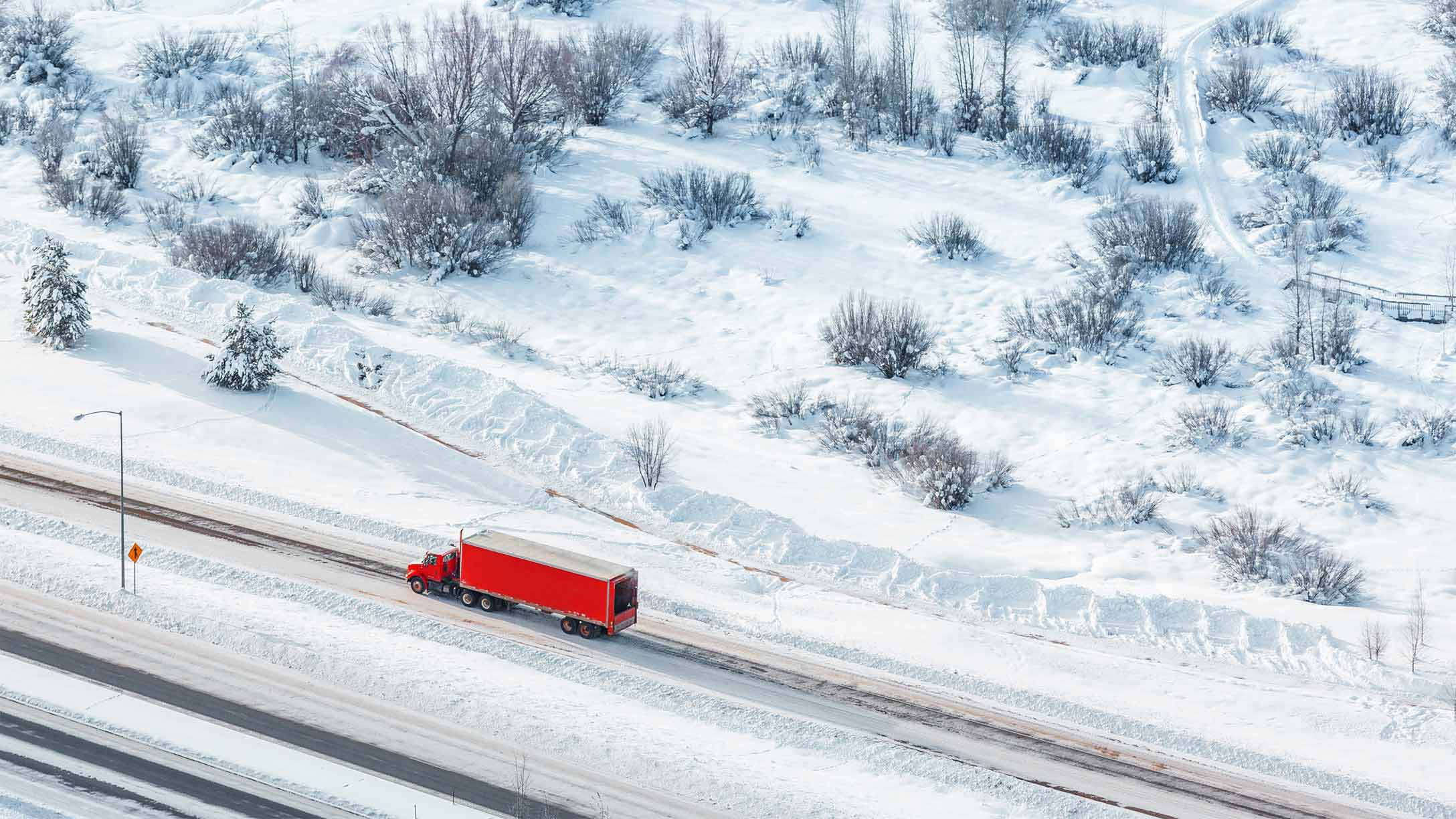9 ways to winterize your vehicle
Adapting to winter weather is a critical step when looking to improve fleet performance.


Winter weather in the north can wreak havoc on vehicles and make it difficult for drivers to perform basic maneuvers safely. Here are a few things you can do to winterize your vehicle and help your drivers reach their destination safely this season.
1. Prioritize visibility
Visibility is always a top concern when trying to improve fleet safety — freezing rain, snow and hail can make it difficult for drivers to see everything that is happening on the road.
- Make sure your winter wipers are in prime condition: Winter wipers come with a rubber covering that keeps ice from collecting on the blades. Travelling with a bad set of wipers can be dangerous if the rubber has deteriorated or has become torn from sitting under the hot summer sun.
- Always keep the washer reservoir full: Washer fluid melts ice and snow that has settled on the windshield. In regions affected by severe daily freezing, windshield de-icer products can speed up the thawing process.
- Equip vehicles with a windshield ice scraper: Take the time to not only clean off the windshield, but the entire vehicle, including side mirrors, headlights and tail lights. Not only does this improve driver visibility, but it also helps make sure other drivers can see your vehicle’s lights.
- Clear all snow and ice from your vehicle before starting your journey: Any snow sitting on your vehicle may fly off into the path of drivers behind you. If a collision occurs, you may be found at fault and responsible for costs.
See also: Protect your fleet from winter weather hazards
2. Switch to winter tires
In the winter, ice and sleet contribute to dangerous, slippery road conditions. Below 7 degrees Celsius, around 44.7 degrees Fahrenheit, regular tires (all-season or summer type) harden and begin to lose their traction on the road. The right set of tires can offer huge advantages in bad winter weather.
- Make sure to install four winter tires: If you choose to install winter tires, do not mix different types of tires on one vehicle. Four winter tires can improve control and traction in winter conditions and can shorten brake distances by 25%.
- Remember that some regions require winter tires: In Quebec, for instance, winter tires are mandatory for vehicles registered in the province, from December 15 and March 15. This legislation resulted in a 5% reduction in road collisions and 3% decrease in related deaths and serious injuries, based on findings from a two-year study by the ministère des Transports du Québec.
- Use studded tires, if permitted, when driving on rough terrain: If you’re in a snowy, mountainous region or driving “off the beaten path,” studded tires can improve traction. You must remove studded tires as soon as winter is over, otherwise you could incur a fine from your state or local patrol agency as these tires can be tough on regular roads and are less effective on bare pavement.
3. Monitor tire pressure
Tire pressure drops roughly 1-2 pounds for every 10 degrees Fahrenheit that the temperature lowers. Click here for a science lesson on why this happens. On newer vehicles, an in-vehicle alert for low tire pressure will be visible to the driver; older vehicles require drivers to check tire pressure manually.
See also: Winter road works compliance: 5 challenges and solutions
4. Check your battery
Vehicle batteries can behave differently in winter. This is a major step during winter to make sure your drivers don’t get stranded at any point without being able to turn on the heater.
- Prioritize battery health checks: A vehicle’s battery and charging system might work well during spring and summer, but in winter your vehicles need a little more “juice.” More power is needed to start your engine in the cold, and you also get less power from your battery.
- Consider carrying an power inverter: For those traveling in remote areas, some carry an on-board power inverter with the ability to jump a vehicle battery. These can also charge cell phones and often have an emergency light built in too.
5. Keep an eye on your EV’s range
Electric vehicles also perform differently in the winter, as range can decrease in lower temperatures. So it's important to remember that you won't get as much range in the winter as you would in the summer.
- Check out our EV-specific tips in the blog: : To what degree does temperature impact EV range?
6. Don’t let your coolant freeze
Checking the coolant in your vehicle is also a vital part of making sure your fleet is prepared for the winter ahead. Pure antifreeze, which is ethylene glycol, will freeze between 0 and -5 degrees Fahrenheit. Some outlets suggest mixing antifreeze with distilled water to lower that freezing point.
7. Stay on top of regular servicing
Certain vehicle components have a higher risk of failure in the winter. Bad hoses, belts, water pumps and spark plugs can cause your drivers to become stranded on the side of the road. This is especially dangerous in bad weather as lower temperatures can affect the health and safety of drivers when the vehicle is unable to run or provide warmth.
- Implement regular, preventive maintenance servicing during the winter months: It is difficult to keep track of the last time the various components were checked. Many fleets are looking to automation to better track maintenance schedules. A predictive maintenance system can help decrease downtime and costs, and minimize unforeseen component failure. By pre-scheduling maintenance before the change in seasons, you can help ready the fleet for harsh winter conditions. Learn more about proactive maintenance using MyGeotab here.
- Consider a roadside assistance program: Roadside assistance programs can minimize downtime in the unfortunate event that your vehicle breaks down in the middle of a journey. This is especially important in the winter months when vehicle breakdowns can leave drivers with no access to heat on a cold winter day.
8. Monitor fuel levels
The last thing you want is for a driver to get stranded in dangerous conditions because of low fuel levels and cause a negative impact to the business such as delay or possible injury.
- Encourage drivers to always keep fuel levels above half-a-tank: Having your vehicles run out of fuel in the middle of a delivery or a trip also may lead to additional cost like towing or emergency services. It will also lead to the driver not being able to stay warm in those cold conditions. This will mean more downtime due to fueling, but is worthwhile when we consider the ramifications of a stranded driver in a dangerous situation, especially in regions with spotty cellular coverage, or no coverage at all.
- Harness fleet technology to monitor fuel levels: By setting your MyGeotab rules to monitor fuel levels, you can get notifications if it dips below a certain percentage. For Diesel fueled vehicles we can also measure and monitor the Diesel Exhaust Fluid (DEF) Level as well as the Diesel Particulate Filter (DPF).
.png)
.png)
9. Stay on top of aggressive driving
Aggressive driving is a key contributor to vehicle collisions throughout the year and this only increases during the winter because of the slick driving conditions.
- Monitor dangerous driving with fleet technology: In MyGeotab, you can set real time alerts and run exception-based reports to capture the number of incidents or percentage of times that vehicles/drivers are breaking exception rules based on duty classification. These metrics can be tweaked during the colder months to target winter-specific concerns such as harsh braking, which when done in the winter, can lead to a higher risk of collisions.
.png)
Conclusion: Be prepared for anything
You never know when a blizzard will hit, that might leave vehicles stuck and stranded in hazardous areas, like freeways. Drivers should always have a winter preparedness kit onboard containing items such as:
- Water bottles that won’t burst if frozen
- Non-perishable food
- Blankets and extra warm clothing
- First-aid kit
- Seatbelt cutter
- Whistle
- Wind-up flashlight
- Shovel
Cold weather and winter road conditions can affect the safety of your vehicles and drivers.
With these tips, we hope your fleet has a safe winter.
Subscribe to get industry tips and insights

Kevin De Sousa is a Senior Solutions Engineer, OEM for Geotab.
Table of Contents
Subscribe to get industry tips and insights
Related posts

The fleet safety incentive program checklist for driver engagement that lasts
June 19, 2025
2 minute read

Building a self-sustaining school bus driver safety program with Geotab Vitality
June 13, 2025
7 minute read

55+ Surprising distracted driving statistics and facts for 2025
May 30, 2025
8 minute read

Driving the Future of Public Safety: My Experience at Axon Week 2025
May 21, 2025
2 minute read

The Weight on Our Roads: Prioritising Driver Wellbeing for a Safer Future
May 13, 2025
1 minute read
